The Motherlode: The Full Story of the $87,000 Pair of Levi’s Jeans
Michael Allen Harris, denim archaeologist and author of Jeans of the Old West: A History, has spent the last few decades digging in abandoned mine shafts looking for blue gold and documenting his finds for collectors and enthusiasts.
Michael Allen Harris, denim archaeologist and author of Jeans of the Old West: A History, has spent the last few decades digging in abandoned mine shafts looking for blue gold and documenting his finds for collectors and enthusiasts. About five years ago, after more than 50 journeys into mines all over the country, he struck the motherlode: a pair of nineteenth-century Levi’s in wearable condition complete with an intact patch and pocket bags.
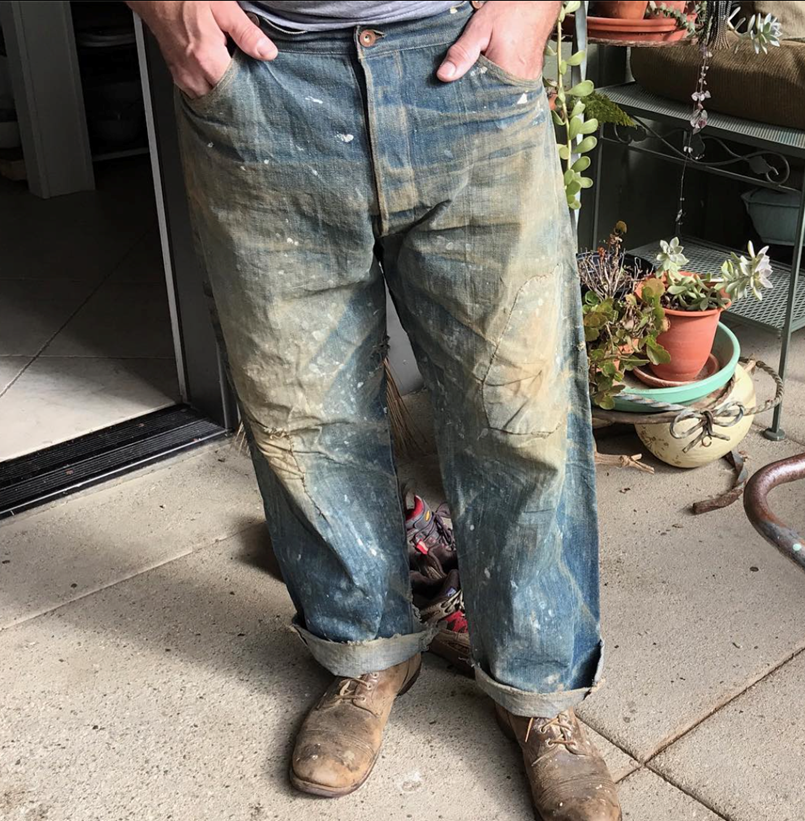
Author and denim archaeologist Michael Allen Harris wearing the $87k jeans Finds like this are the kind of thing that denimhunters dream of. He brought the pair to one of the most colourful characters in the denim scene, fellow denim archaeologist and dealer Brit Eaton. Eaton’s great-great-grandfather was a treasure-seeker who left Michigan in the nineteenth century in search of gold in Nevada. Like Harris, Eaton regularly crawls head-first into mine shafts, attics, crawl spaces, and barn lofts looking for long-ago-forgotten and discarded treasures, and he fell head over cuffs in love with the pair that Harris brought to him. The two engaged in what Eaton calls a “hardcore, stressful showdown.” At the end of the day, Eaton managed to convince Harris to part with the pair for the low price of $23,000.
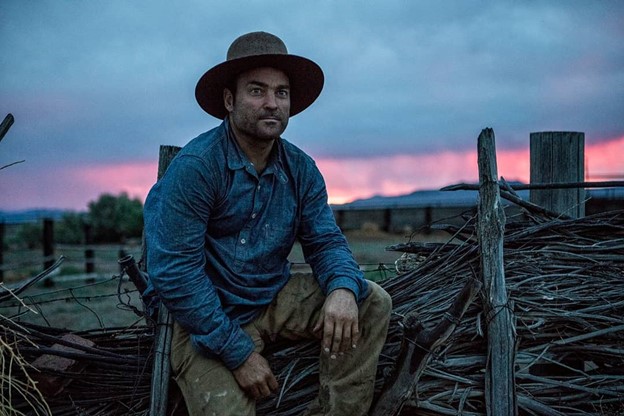
Vintage denim legend Brit Eaton – Photo from Denimhunters Eaton never planned to sell the jewel of his collection, but he also needed a “headliner” for his Durango Vintage Festivus. The schedule for the Colorado gathering of vintage lovers from around the world already featured musical acts, literal tons of vintage clothing, a denim olympics, and a vintage scavenger hunt, but knew that the beautiful nineteenth-century pair would be a huge draw card for the festival.

The pair was displayed before the bidding began to let potential buyers whet their appetites and cash out their other investments—early estimates suggested the pair would go for between $80-100k. All the hallmarks of the true original were there: the cinch back, the suspender buttons, the single back pocket (the second one wouldn’t be added until 1902), the leather patch, and of course the rivets.

The original owner had worn the Amoskeag selvedge (then reputed the best in the world) down to a soft shade of sky-blue across the seat, but there was still plenty of life in it. Tagged a size 38 with a 32” inseam, they’d been cut and washed by the owner down to a 36” waist and a 30” inseam. There were traces of candlewax that had been dripped onto the denim, probably from a head-mounted lamp. The right knee had been repaired, and there was a hole big enough to push a lemon through it in the left knee, but the jeans were in incredible condition—especially considering their age. You could still, said one of the pair’s current owners, “wear them to a Starbucks.” The bell rang signalling the opening of the auction, and bidding was lively. Those who were hoping for a bargain were quickly disappointed. The first bid came in from an eager online buyer: $28,000. While the room was still recovering from the shock of hearing that number, the second bid came in: $50,000. Gasps could be heard rippling through the crowd. In the end it came down to a slow-moving bidding war between Kyle Haupert, a 23-year-old vintage dealer from Golden State Vintage, and Monique Buzy-Pucheu of Buckleback Archive, a denim consulting firm with a laundry list of high-profile denim brands. Monique went as high as $75,000, and it looked like that would be the end of it, but Haupert’s bidding partner, Zip Stevenson, raised his hand one last time to place a $76,000 bid. Monica graciously bowed out. After the 15% buyer’s premium, the total came to $87,400.
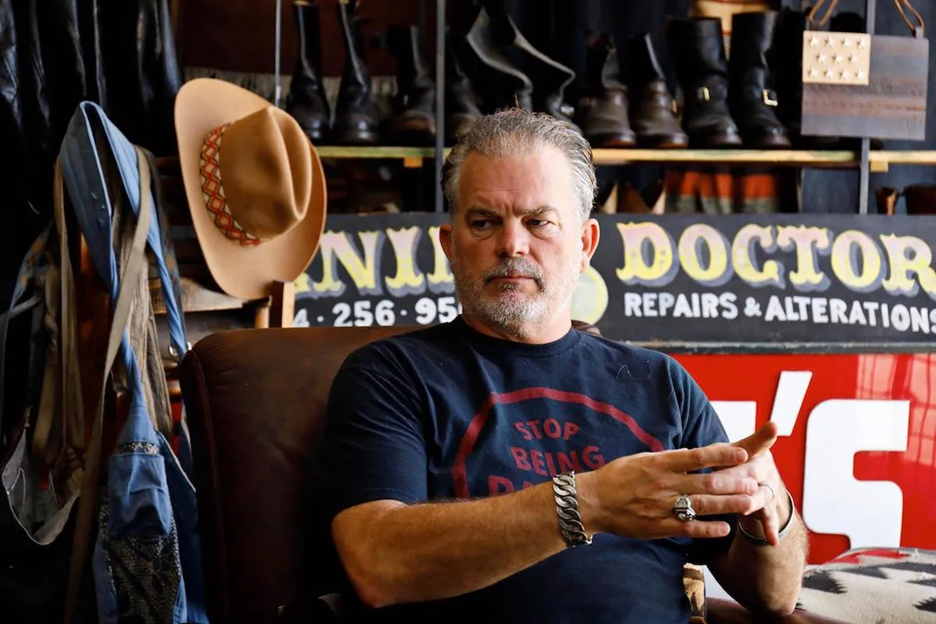
Zip Stevenson – Photo from WWD Japan The younger denim lover put up 90% of the money, and Stevenson contributed the remaining 10%. Haupert will bear most of the risk, but he knows that Stevenson, a vintage denim veteran and one of the founders of Stevenson Overalls, has a laundry list of salivating collectors who will all want a piece of the once-in-a-lifetime pair. Zip and Kyle are both avid vintage hounds, but they’re also shrewd businessmen, so it’s likely that the jeans will change hands again in the foreseeable future. Before the auction started, The Metropolitan Museum had expressed interest to Eaton. When the auction started, the man in charge of the Met’s bid was M.I.A.—sound asleep, it turned out, in a Paris hotel room. He may have missed an opportunity to scoop up the jeans for less than $100,000. If the Met wants to add the jeans to their collections, they’ll have to contend with some deep-pocketed collectors in Stevenson’s Rolodex. Though they are the oldest pair to ever sell at a live auction, they’re not the oldest pair of wearable Levi’s to ever fall under the hammer. At Levi’s San Francisco headquarters, locked in a fire-proof vault in a temperature-controlled room (65 degrees, if you’re curious) is a pair of XX Levi’s waist overalls produced in 1879. The brand purchased them from a dealer for around $40,000, but they’ve since insured the pair for $150,000. With the right bidders present, the treasured pair would probably blow through this valuation. A pair of Levi’s from the 1890s sold to a private buyer in Asia for nearly $100,000 in 2018, so the precedent for a six-figure vintage denim sale is tantalizingly close.
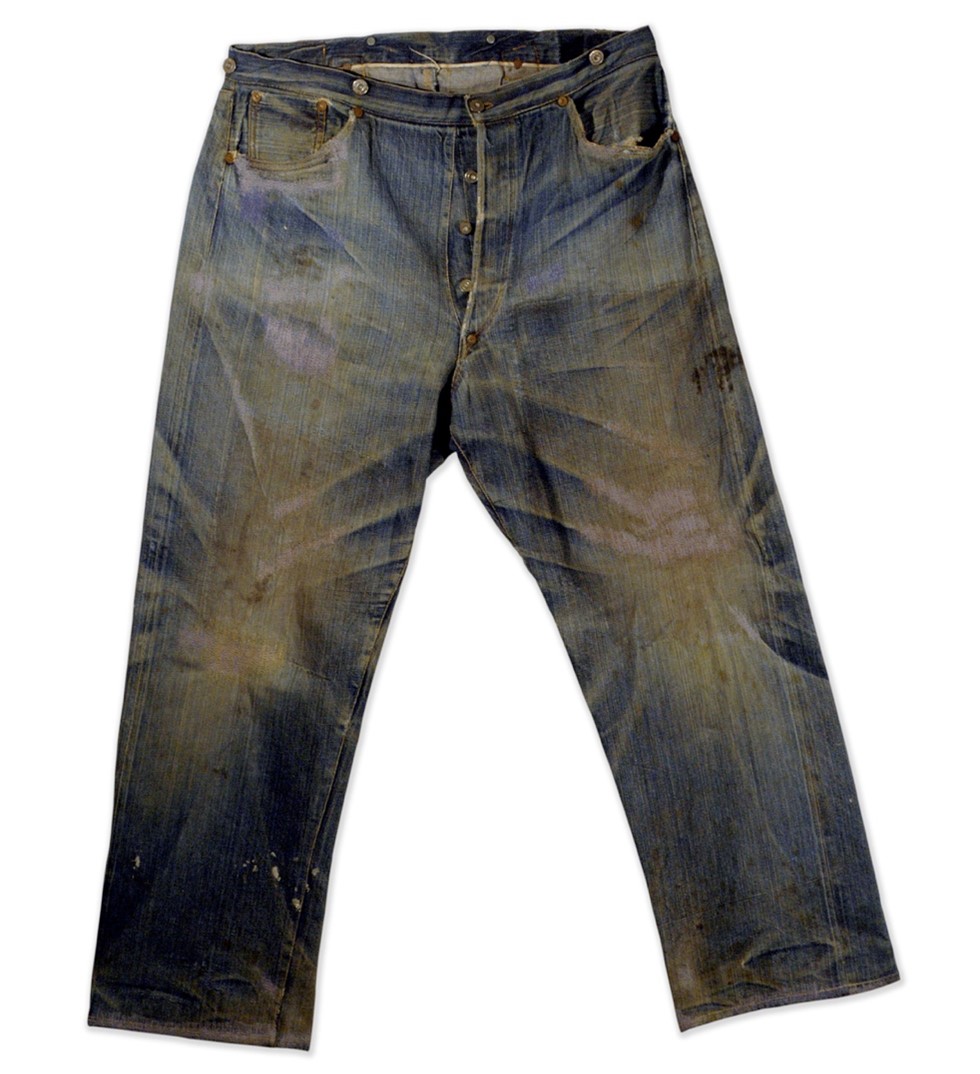
Levi’s treasured 1879 pair – Photo from Levi’s Since the auction, there’s been a whirlwind of coverage surrounding this pair—a product of both the astronomical price tag and the fact that the pair bear a legible reminder of America’s racist legacy. Included in the text printed on the pocket bag is the phrase “The only kind made by white labor.” Headlines focused on the racist slogan, prompting Levi’s to issue a statement, saying they are “wholly committed to using our platform and our voice to advocate for real equality and to fight against racism in all its forms.”
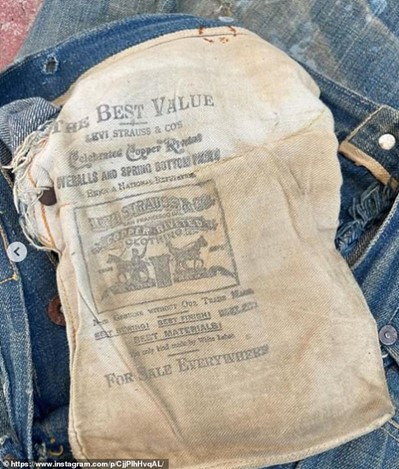
“The only kind made by White Labor” The racist label is the product of a deeply racist time. The gold rush of 1849 had brought Americans seeking their fortunes to the West, where they were joined by immigrants from Europe and China. The Chinese immigrants were, from the first, treated as second-class citizens. They were, according to Levi’s historian Lynn Downey, “marginalized, harassed, [and] evicted.” In the mid-1870s, a financial downturn saw San Francisco’s manufacturers looking for cheap labour. They found that they could pay Chinese immigrants far less than their white counterparts, exacerbating the already fraught race relations and lifting the tide of anti-Chinese sentiment.
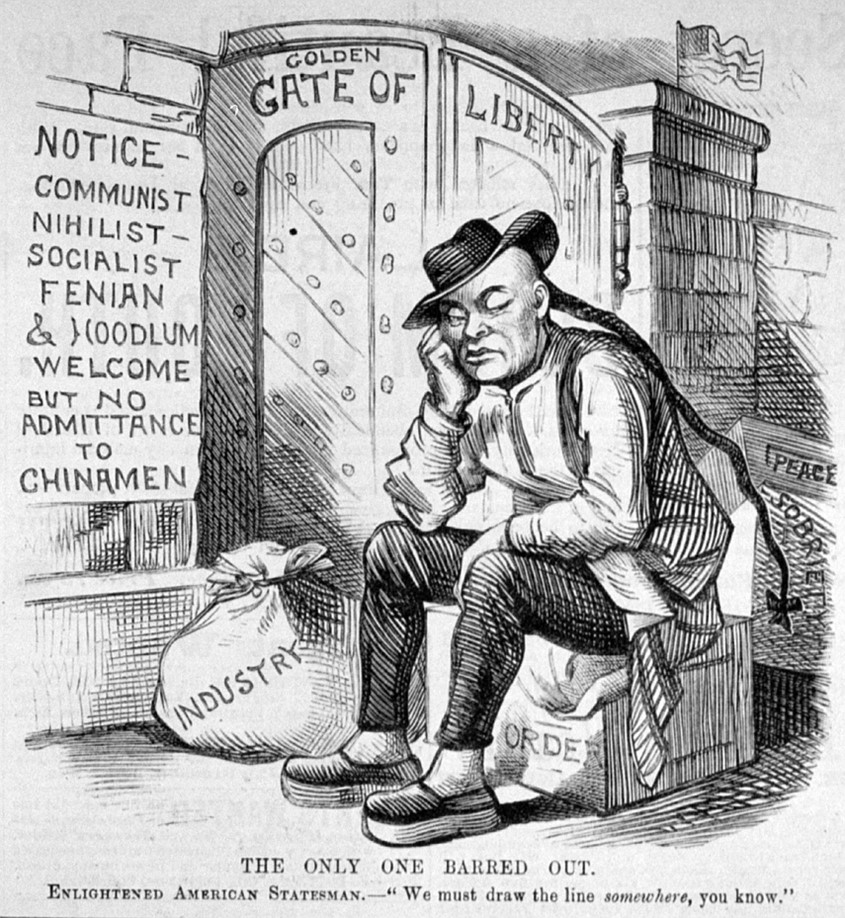
19th-Century Political Cartoon In 1876, a San Francisco newspaper published an article claiming that Levi’s employed 500 Chinese employees. Levi’s published a response the very next day, correcting the article by noting that they only had a single Chinese employee, who was “employed for labor which white men have again and again tried and failed to do.” Regardless of the truth of the allegations, Levi Strauss felt compelled to repudiate them and to emphasise his support for “home production” and the “honest toil of the white working people.” To modern ears, these words (like the ones printed on the pocket bags) are like nails on a chalkboard. Strauss was not, it seems, immune to the prejudices of his day. The Chinese Exclusion Act of 1882, which not only banned Chinese immigration but also barred existing immigrants from obtaining citizenship, codified this prejudice at a federal level, and, especially in San Francisco, it was not uncommon for merchants and manufacturers to openly advertise their support for “home” industry and white labour in the second half of the century. Some unions and manufacturers bucked this trend, but Levi’s was apparently not among them. The nineteenth-century jeans that sold at auction open the page onto a dark chapter of both America’s and Levi’s history. As excited as we are to see a dusty relic from denim’s infancy pulled out of the mine shaft and brought into the light, it brings with it all the baggage of its time. We can only hope that these jeans end up in a museum, where they can be properly presented and contextualized.
Hazine: 87.000$'lık Levi's Jean Pantolonun Hikayesi
Denim arkeoloğu ve Jeans of the Old West: A History kitabının yazarı Michael Allen Harris, geçtiğimiz yılları terk edilmiş maden ocaklarında tabiri caizse mavi altın arayarak ve bulduklarını koleksiyoncular ve meraklılar için belgeleyerek geçirdi. Harris, yaklaşık beş yıl önce, ülkenin dört bir yanında yer alan 50'den fazla madeni gezdikten sonra bir hazine buldu: giyilebilir koşulda, jakronu bozulmamış ve cepleri sağlam durumda olan, 19. yüzyıldan kalma bir Levi's jean pantolon.
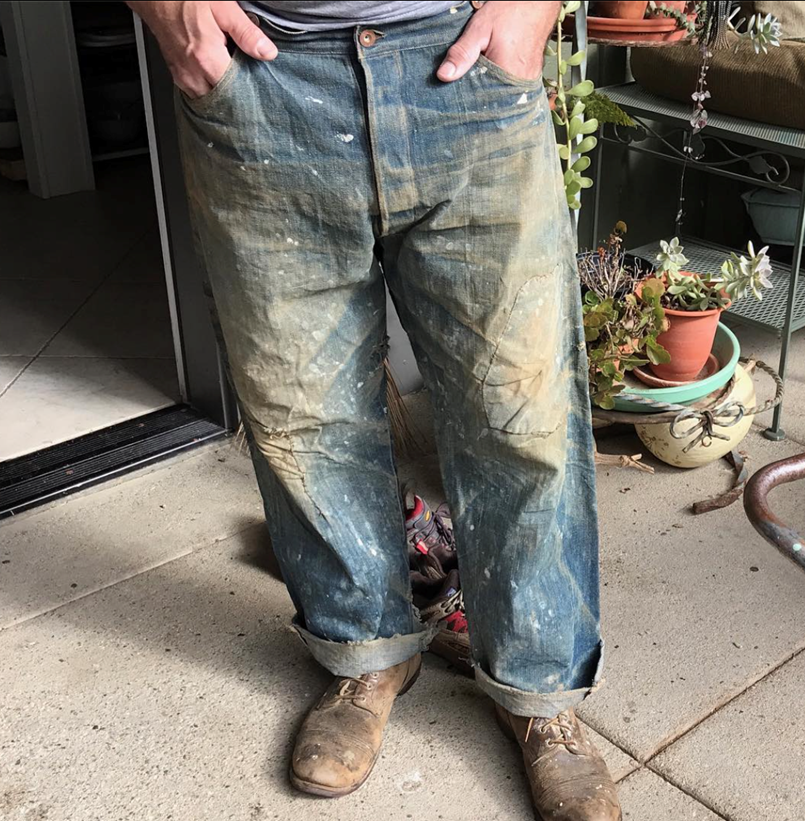
Yazar ve denim arkeoloğu Michael Allen Harris, 87 bin dolarlık jean pantolonu deniyor Bu tür buluntular, jean avcılarının hayalini kurduğu türden şeyler. Harris, pantolonu bulduktan sonra denim dünyasının en renkli isimlerinden biri olan denim arkeoloğu ve satıcısı Brit Eaton'a götürdü. Eaton'ın dedesinin dedesi, 19. yüzyılda Nevada'da altın arayan Michiganlı bir hazine avcısıydı. Harris gibi uzun zaman önce unutulmuş ve bir kenara atılmış hazineleri aramak için düzenli olarak maden kuyularını, tavan aralarını, döşeme altı boşluklarını ve ahır çatı katlarını arşınlayan bir kaşif olan Eaton, Harris'in kendisine getirdiği pantolona sırılsıklam aşık olmuştu. "Sert, stresli bir pazarlık" olarak tasvir ettiği görüşmenin ardından Eaton, Harris'i, pantolonu ona 23.000$ gibi düşük bir fiyata bırakması için ikna etmeyi başardı.
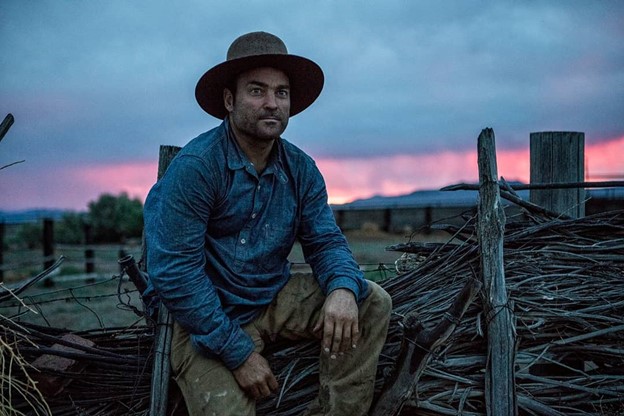
Vintage denim efsanesi Brit Eaton – Fotoğraf: Denimhunters Eaton, koleksiyonunun en sevdiği parçasını satmayı asla planlamıyordu ama bir yandan da Durango Vintage Festivus'u için bir "yıldıza" ihtiyacı vardı. Dünyanın dört bir yanından vintage severlerin Colorado'da bir araya geldiği etkinlikte müzikal gösteriler, birçok vintage kıyafet, denim olimpiyatları ve bir hazine avı olacaktı ama on dokuzuncu yüzyıldan kalma göz alıcı bir pantolonun, festivalin albenisini artıracağının da farkındaydı.

Pantolon, potansiyel alıcıların iştahını kabartmak ve pamuk ellerini ceplerine götürmelerini sağlamak için açık artırma başlamadan önce katılımcılara gösterildi. İlk tahminler, pantolonun 80 ila 100 bin dolar civarında bir fiyata el değiştireceği yönündeydi. Bu pantolonu sahtelerinden ayırt eden bütün özellikleri yerindeydi: arka tarafta yer alan eyer kolanı, pantolon askısı düğmeleri, tek arka cep (1902 yılına kadar jean pantolonların arka kısmına ikinci bir cep eklenmeyecekti), deri yama ve tabii ki perçinler.
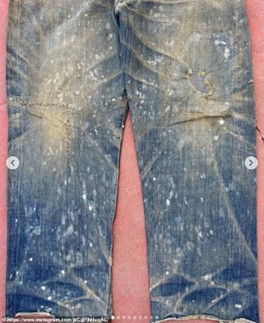
O zamanlar dünyanın en iyisi olarak kabul edilen Amoskeag kumaş kenarına sahip pantolonun kalça kısmının rengi değişmiş ve gökyüzü mavisi bir tona evrilmişti ama pantolonun kendisi hala canlıydı. Etiketine göre boyu 32, genişliği 38 olan pantolon, sahibinin müdahalesiyle boyu 30 ve genişliği 36 olacak şekilde değişmişti. Pantolonda, kaynağı muhtemelen başa takılan bir lamba olan damlamış mum izleri vardı. Pantolonun sağ dizi tamir edilmişti ve sol dizinde ise bir limonun içinden geçebileceği büyüklükte bir delik vardı ama özellikle ne kadar eski olduğu düşünüldüğünde pantolonun durumu oldukça iyiydi. Pantolonun şu anki sahibinin de söylemiş olduğu gibi, "Bu pantolonu giyip Starbucks'a bile gidebilirsin". Müzayedenin açıldığını bildiren zilin çalması ile teklif savaşları başladı. Pantolonu düşük fiyata alabileceklerini düşünenlerin hayal kırıklığına uğraması uzun sürmedi. İlk teklif hevesli bir çevrimiçi alıcıdan geldi: 28.000$. Diğer teklif verenler bu miktarın şokunu henüz atlatamamışken ikinci teklif geldi: 50.000$. Kalabalıktan gelen şok olma seslerini duymamak imkansızdı. Sonunda ayakta iki kişi kalmıştı: vintage kıyafet satıcısı Golden State Vintage'dan 23 yaşındaki Kyle Haupert ve yüksek profilli denim markalarından oluşan bir portföye sahip olan denim danışmanlık firması Buckleback Archive'den Monique Buzy-Pucheu. Bu ikili arasında yavaş ilerleyen bir teklif savaşı yaşandı. Monique 75.000$'a kadar çıktığında iş bitecek gibi görünüyordu ama Haupert'in ortağı Zip Stevenson 76.000$'lık teklif vermek için elini kaldırdı; bu, son teklif olacaktı. Monica nezaketle çekildi. %15'lik alıcı payının da eklenmesinden sonra toplam fiyat, 87.400$'a ulaştı.
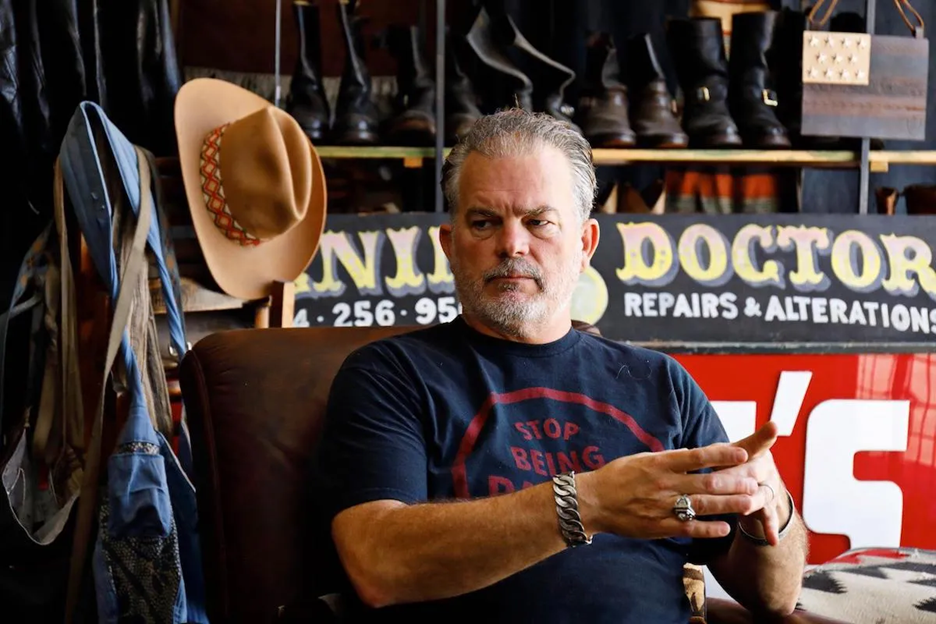
Zip Stevenson – Fotoğraf: WWD Japonya Genç denim sever ücretin %90'ını karşılarken geri kalan %10'luk kısmı da Stevenson tamamladı. Haupert belki de riskin çoğunu üstlenecekti ancak kadim bir denim ustası ve Stevenson Overalls'ın kurucularından biri olan Stevenson'ın, dünyada eşi benzeri olmayan bu pantolona talip olacak, deyim yerindeyse sağ avuçlarını kaşıtan koleksiyonculardan oluşan bir portföye sahip olduğunu biliyordu. Zip ve Kyle'ın ikisi de sağlam birer vintage sever ama aynı zamanda kurnaz birer iş adamı, bu yüzden yakın gelecekte bu jean pantolonun tekrar el değiştirmesi kuvvetle muhtemel. Müzayede başlamadan önce Metropolitan Müzesi, Eaton ile ilgilendiğini belirtmişti. Müzayede başladığında Met'in teklifinden sorumlu kişi ortada yoktu; sonradan anlaşıldı ki kendisi, Paris'teki bir otel odasında mışıl mışıl uyuyordu. Bu sebepten ötürü jean pantolonu, 100,000$'dan daha düşük bir fiyata ellerine geçirme şansını heba etmiş oldular. Met, koleksiyonuna jean pantolonlar eklemek istiyorsa Stevenson's Rolodex'teki bazı kirli çıkı koleksiyoncularla mücadele etmek zorunda kalacak. Her ne kadar canlı bir müzayede ile satılan en eski pantolon olsa da bu pantolon, açık artırmaya çıkarılan ve giyilebilir durumda olan en eski Levi's pantolon değil. Levi's'ın San Francisco genel merkezinde, sıcaklık kontrollü bir odada (meraklılarına: 18°C) yangına dayanıklı bir mahzende kilitli, 1879'da üretilmiş bir XX Levi's tulum var. Marka, bu pantolonu bir bayiden yaklaşık 40.000$'a satın aldı ama sigortalamak için 150.000$'ı gözden çıkardılar. Olur da teklif vermek isteyen olursa bu miktarın üzerine çıkmak durumunda. 1890'lardan kalma bir Levi's pantolon, 2018'de Asya'dan bir alıcıya yaklaşık 100.000$'a satıldı, bu nedenle altı rakamlı bir miktar karşılığı vintage denim satışı çok yakın görünüyor.

Levi's'ın 1879 yılından kalma değerli pantolonu – Fotoğraf: Levi's Müzayededen bu yana, bu pantolonla alakalı arka arkaya haberler çıktı. Bunun altında, hem pantolon için ödenen astronomik ücret, hem de pantolonun Amerika'nın ırkçı mirasının bir göstergesi olması yatıyor. Pantolonun iç yüzünde, cebin üzerinde yer alan yazıda “Beyaz İşçi emeği ile üretilen tek ürün” ibaresi yer alıyor. Manşetler bu ırkçı ifadeye odaklandığı için Levi's, "kendilerini gerçek eşitliği savunmaya adadıklarını ve platformlarını ve seslerini ırkçılığın her türüyle karşı mücadele etmek için kullanmaya devam edeceklerini" açıklama ihtiyacı duydu.
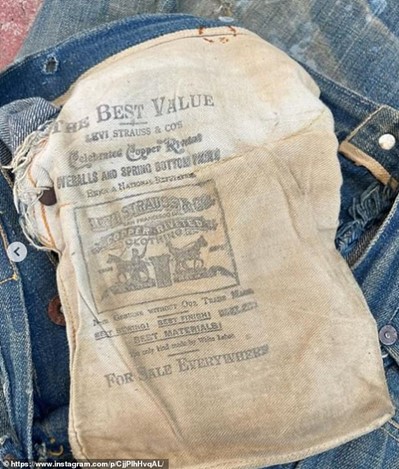
“Beyaz İşçi emeği ile üretilen tek ürün” Bu ırkçı söylem, ırkçılığın oldukça yaygın olduğu bir döneme ait. 1849'daki Kaliforniya Altına Hücum dönemi, zengin olmaya çalışan Amerikalılar ile Avrupa ve Çin'den gelen göçmenleri ülkenin batısında buluşturmuştu. Bu dönemde Çinli göçmenler, geldikleri günden beri ikinci sınıf vatandaş muamelesi görüyordu. Levi's tarihçisi Lynn Downey'e göre Çinli göçmenler "ötekileştirildi, taciz edildi [ve] kovuldu." 1870'lerin ortalarında yaşanan mali gerileme ile San Francisco'nun fabrikatörleri, ucuz işgücü aramaya başladılar ve Çinli göçmenlerin, aynı işleri Amerikalı meslektaşlarından çok daha düşük ücretler karşılığı yaptığını keşfettiler. Bu durum, halihazırda gergin olan ırkçı hisleri güçlendirdi ve Çinli göçmenlere karşı olan yaklaşımın kötüleşmesine sebep oldu.
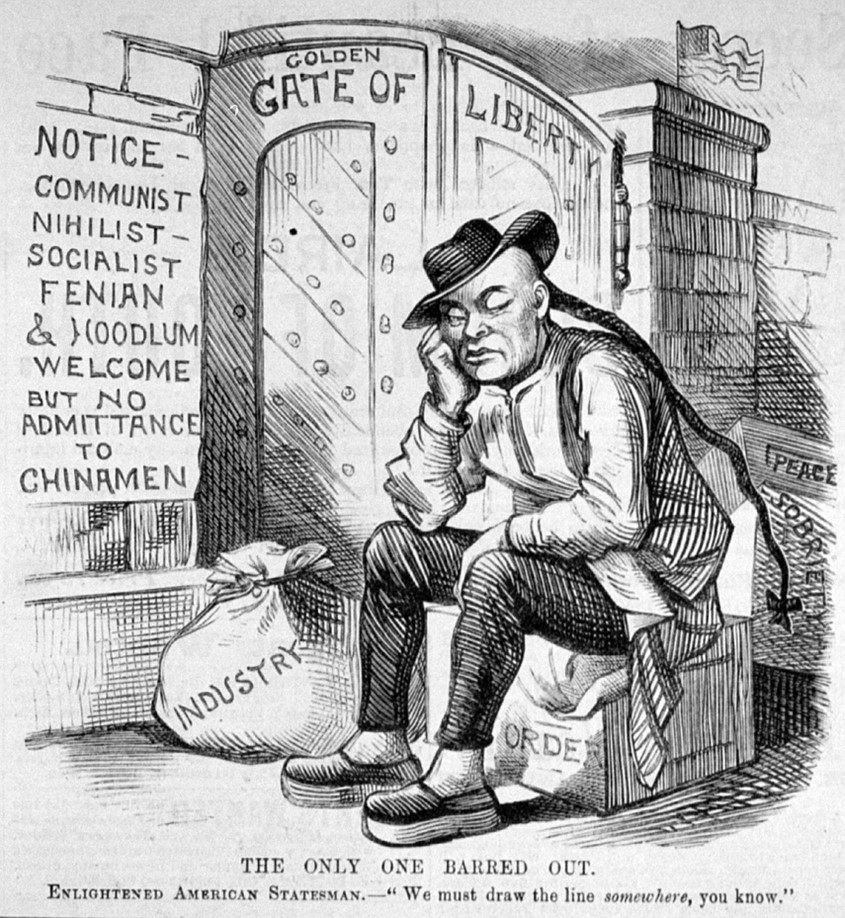
19. Yüzyıla ait Bir Siyasi Karikatür 1876'da San Francisco'da yayımlanan bir gazete, Levi's'ın 500 Çinli işçi çalıştırdığını iddia eden bir makale yayınladı. Levi's hemen ertesi gün bu iddiayı yanıtladı ve söz konusu makalenin doğruyu yansıtmadığını belirterek "beyaz çalışanların defalarca denediği ancak başaramadığı işler için çalıştırılan", yalnızca tek bir Çinli çalışanı olduğunu açıkladı. İddiaların doğruluğundan bağımsız olarak Levi Strauss, Çinli işçi çalıştırdığını reddetmek ve "yerli üretime" ve "beyaz emekçilerin dürüst emeğine" verdiği desteği vurgulamak zorunda hissetti. Pantolonun cebine basılana benzer ırkçı ifadeler, günümüz insanlarını ciddi anlamda rahatsız ediyor. Görünüşe göre Strauss, zamanının önyargılarından muaf değildi. Yalnızca Çinlilerin ülkeye göçünü yasaklamakla kalmayan, aynı zamanda ülkedeki mevcut göçmenlerin vatandaşlık almasını da yasaklayan 1882 Çin Dışlama Yasası, bu önyargıyı federal düzeye taşıdı. Yüzyılın ikinci yarısında, özellikle San Francisco'da, tüccarların ve imalatçıların "yerli" üretime ve beyaz emeğe olan desteklerini sesli bir şekilde dile getirmeleri pek de alışılmadık bir durum değildi. Bazı sendikalar ve imalatçılar bu eğilime karşı çıksa da Levi's, bu aktörlerin arasında yer almıyordu. Müzayedede satılan ve tarihi on dokuzuncu yüzyıla dayanan jean pantolon, hem Amerika hem de Levi's tarihinin karanlık bir sayfasına ışık tutmuş oldu. Her ne kadar denimin ilk dönemlerini görmüş geçirmiş tozlu bir kalıntının bir maden kuyusundan çıkarılması bizi heyecanlandırmış olsa da bu kalıntı, zamanının nahoş normlarının bir kanıtı olarak göze çarpıyor. Umarız bu jean pantolon, bir gün uygun şekilde sergilenebileceği ve doğru anlamı kazanabileceği bir müzede sergilenir.
To view full content and a better mobile experience, try



